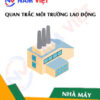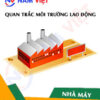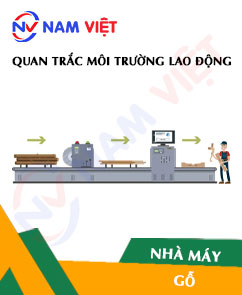Occupational environment monitoring at an aircraft manufacturing factory
99,000 ₫
Note: The above price is calculated for one sample, the price may vary depending on the area of the environment to be monitored and market fluctuations. For more accurate pricing support, please refer to the price list or contact our consulting staff directly.
Monitoring the environment of an aircraft manufacturing factory is a session of collecting, analyzing, and evaluating workplace factors that may be harmful to workers’ health.
Table of Contents
Toggle1. Overview of Aircraft Manufacturing Factories
a. What is an aircraft manufacturing factory?
Aircraft manufacturing factory is a production facility specializing in the production and assembly of aircraft. It is where aircraft parts and components are manufactured, assembled, and tested to create complete aircraft. In an aircraft manufacturing factory, production and assembly processes are usually carried out following strict procedures and standards to ensure the quality and safety of the final product.
Aircraft manufacturing factories typically have specialized systems and machinery to carry out production and assembly processes. This includes metalworking machines, composite cutting machines, welding machines, stamping machines, quality inspection machines, etc.

b. Production stages in an aircraft manufacturing factory
The production stages in an aircraft manufacturing factory usually include the following:
- Design and development: This stage involves the process of designing and developing models, drawings, and new technologies for aircraft. It includes research, analysis, and testing to determine technical requirements, calculate structures, and design aircraft systems.
- Component manufacturing: This stage focuses on producing basic aircraft components, including wings, engines, fuselage, tail, engine covers, electrical systems, control systems, etc. Manufacturing processes may include metalworking, composite processing, casting, stamping, and welding.
- Assembly: The assembly stage is the process of joining manufactured components and parts into a complete aircraft. It includes installing main components such as engines, wings, tail, electrical systems, fuel systems, control systems, interior, etc.
- Inspection and testing: Completed aircraft undergo strict inspection and testing procedures to ensure stable operation and compliance with safety and quality standards. Inspections include functional tests, test flights, emission checks, stress tests, heat resistance tests, etc.
- Finishing and delivery: The final stage is finishing the aircraft and delivering it to the customer or operator. It includes painting and exterior decoration, interior installation, final inspection, and quality check before aircraft handover.

c. Types of machinery used in aircraft manufacturing factories
Aircraft manufacturing factories use various specialized machinery and equipment to carry out aircraft production and assembly processes. Here are some common types of machinery used in the aircraft manufacturing industry:
- Metalworking machines: Including lathes, milling machines, grinders, and cutting machines for processing aircraft metal parts.
- Composite processing machines: Composite materials are widely used in aviation. Composite processing machines include composite cutters, composite drills, and automated machines for handling composite parts.
- Welding machines: Used to weld metal and composite parts during aircraft assembly.
- Stamping machines: Used to create embossed details on metal parts.
- Inspection and measurement machines: Including precision measurement machines, strength testing machines, vibration measuring devices, spectrometers, leak testers, etc., to inspect and ensure the quality of parts and aircraft.
- Strength testing machines: Used to test the load-bearing capacity of aircraft structures.
- Test flight machines: Used to test aircraft under simulated flight conditions to evaluate performance and ensure safety.
- Painting and decoration machines: Including paint spraying machines, paint drying machines, and equipment for painting and decorating aircraft exteriors.
- Assembly and installation machines: Including lifts, transport machines, and equipment to install components and parts during aircraft assembly.
- Cutting, bending, and processing machines for other materials: For non-metal parts such as plastics, wood, composites, carbon fiber, other cutting, bending, and processing machines are used.

d. What occupational diseases may occur for workers in aircraft manufacturing factories?
Workers in aircraft manufacturing factories may be exposed to certain environmental and occupational factors that can cause health problems and occupational diseases. Below are some common occupational diseases that workers in the aircraft manufacturing industry may encounter:
- Noise: Workers in aircraft factories are exposed to noise from machinery and production processes. Continuous high-intensity noise can negatively affect hearing and cause hearing loss or deafness.
- Chemicals: Working in aircraft manufacturing may involve the use and exposure to chemicals such as solvents, chemical compounds, and cleaning agents. Improper use, storage, or protection from these chemicals can lead to health hazards including dermatitis, skin irritation, respiratory problems, and other health issues.
- Dust and particles: Metalworking and composite processing in aircraft factories can produce dust and fine particles. Long-term exposure to dust and particles can cause pneumonitis, respiratory issues, and lung diseases.
- Work-related injuries: Job positions in aircraft factories may require uncomfortable postures or high concentration, such as working in confined spaces or at heights. This can cause musculoskeletal issues, back and neck problems.
- Temperature and environmental impacts: The working environment in aircraft factories may have high or low temperatures, high or low humidity, and varying air pressure. This can lead to body temperature control issues, fatigue, and discomfort.

e. Common types of aircraft on the market
There are many common types of aircraft on the market today, including:
- Passenger aircraft:
- Jet aircraft: Airbus A320, Boeing 737, Airbus A380, Boeing 787.
- Medium and small aircraft: Embraer E-Jet, Bombardier CRJ Series, ATR 72.
- Business aircraft: Gulfstream G650, Bombardier Global Express, Dassault Falcon.
- Cargo aircraft:
- Light cargo aircraft: Cessna Caravan, Pilatus PC-12.
- Heavy cargo aircraft: Boeing 747-8F, Antonov An-124, Lockheed C-130 Hercules.
- Fighter aircraft:
- Multirole fighters: F-16 Fighting Falcon, F-35 Lightning II, Eurofighter Typhoon, Dassault Rafale.
- Jet fighters: MiG-29 Fulcrum, Su-35 Flanker, F/A-18 Super Hornet.
- Trainer aircraft:
- Basic trainers: Beechcraft T-6 Texan II, Pilatus PC-21.
- Advanced trainers: Aero L-39 Albatros, BAE Systems Hawk, M-346 Master.
- Unmanned combat aerial vehicles (UAVs):
- Combat UAVs: General Atomics MQ-9 Reaper, Predator B, China Wing Loong.
- Surveillance and reconnaissance UAVs: DJI Phantom, DJI Mavic, AeroVironment Puma.
2. Overview of Occupational Environment Monitoring Services
a. What is occupational environment monitoring in aircraft manufacturing factories?
Occupational environment monitoring (or workplace environmental measurement) in aircraft manufacturing factories is the activity of collecting, assessing, and analyzing measurement indicators of occupational environmental factors at the aircraft factory. The goal is to implement timely measures, minimize environmental impacts on worker health, and prevent occupational diseases. Occupational environment monitoring is a mandatory requirement for aircraft manufacturing factories.
Occupational environment monitoring plays a crucial role in caring for, protecting, and enhancing workers’ health, as workers are the primary resource of enterprises and directly generate profit. Workers who are frequently exposed to risk factors exceeding allowable limits will suffer health effects and develop occupational diseases.
REGISTER FOR OCCUPATIONAL ENVIRONMENT MONITORING SERVICE
b. Nam Viet’s occupational environment monitoring program
Nam Viet’s occupational environment monitoring program is a program developed by monitoring engineers in the field of occupational safety and environmental protection. Aiming to ensure the health and safety of workers, this program uses modern measurement methods to monitor air, water, and microclimate, physical, and dust factors in the workplace. This program is essential for ensuring a safe working environment and protecting workers’ health.
Additionally, Nam Viet’s monitoring program also plays an important role in researching and developing new solutions to improve workplace environmental quality. With the dedication and professionalism of monitoring experts, Nam Viet’s exclusive monitoring program is a breakthrough in occupational safety and environmental protection management in Vietnam.

c. Standardization in occupational environment measurement procedures
Standardization in Nam Viet’s occupational environment measurement procedures is crucial for ensuring the accuracy of results. To guarantee precision and reliability, this program uses recognized standards and standardized procedures from Ho Chi Minh City Department of Health. This ensures that collected data can be reliably used in evaluating workplace conditions and making decisions to improve the working environment for worker health protection.
These standardized procedures also ensure that measurements are conducted by highly qualified monitoring specialists with years of experience, enabling managers and experts to trust results from An Toan Nam Viet and make accurate, valuable decisions in safeguarding worker health and the environment.
By applying standardization in measurement procedures, Nam Viet demonstrates its commitment to ensuring a safe working environment and protecting worker health, while contributing positively to the development and improvement of occupational safety and environmental protection management in Vietnam.
d. Aircraft factory monitoring result reports
Occupational environment monitoring results are compiled according to Form No. 04, Appendix III issued with Decree 44/2016/ND-CP and prepared in 02 copies: 01 copy for the contracting enterprise conducting the occupational environment monitoring and 01 copy retained by the monitoring organization.
The retention period for occupational environment monitoring results is indefinite according to legal regulations.

e. Frequency of occupational environment monitoring as required by law
According to clause 2 of Article 18, Law on Occupational Safety and Hygiene 84/2015/QH13, employers must organize occupational environment monitoring to assess harmful factors at least once per year.
f. Deadline for submitting occupational environment monitoring reports as required by law
The deadline for submission is before December 31 each year. Enterprises at production facilities are required to submit occupational environment monitoring results to the local Department of Health where the enterprise’s head office and workplaces are located.
When there are changes in technology, production processes, or during renovation/upgrading of facilities with potential new harmful factors affecting worker health, enterprises must update their occupational hygiene records regarding the harmful factors requiring occupational environment monitoring.
g. Penalties for violations of occupational environment monitoring by employers
According to Article 27 of Decree No. 12/2022/ND-CP dated 17/01/2022 on administrative penalties in labor, social insurance, and Vietnamese workers working abroad under contract:
- Clause 2: Fines from 2,000,000 – 5,000,000 VND for employers who fail to publicly disclose monitoring results and hazard management results to workers at monitored workplaces immediately after obtaining them.
- Clause 3: Fines from 20,000,000 – 40,000,000 VND for employers who fail to conduct occupational environment monitoring to control health impacts on workers as required by law.
- Clause 4: Fines from 40,000,000 – 60,000,000 VND for employers who collude with monitoring organizations to commit fraud in occupational environment monitoring activities but not reaching criminal liability.
3. Harmful Environmental Factors for Workers in Aircraft Manufacturing Factories
Workers in aircraft manufacturing factories may be exposed to the following harmful environmental factors:
- Noise: Aircraft and related production equipment generate high levels of noise, affecting workers’ hearing. Prolonged and intense noise can cause hearing loss, stress, and insomnia.
- Dust and chemicals: Aircraft manufacturing processes can generate dust and chemicals in the working environment. Metal dust, chemicals, plastic particles, and paint can irritate the respiratory tract, cause breathing problems, pneumonia, or more severe issues such as chemical-induced pneumonia.
- Toxic gases: Some aircraft production processes may produce toxic gases such as welding fumes, welding gases, saturated gases, and additives. Exposure to these gases can lead to health issues such as suffocation, fatigue, loss of consciousness, and nervous system problems.
- Temperature and humidity: Aircraft factories may have working environments with high or low temperature and humidity. This can cause body temperature regulation problems, fatigue, and discomfort.
- Ultraviolet rays: Painting, surface coating, and working with reflective materials may expose workers to strong ultraviolet rays. UV rays can cause skin burns, negative effects on the eyes, and are associated with skin and eye problems.
REGISTER FOR OCCUPATIONAL ENVIRONMENT MONITORING SERVICE
4. Measures to Improve the Working Environment in Aircraft Manufacturing Factories
To improve the working environment in aircraft manufacturing factories, the following measures can be applied:
- Ensure ventilation and air management systems: Provide efficient ventilation systems to clean the air and remove dust, chemical fumes, and toxic gases. Ensure that the air management system complies with safety and environmental regulations.
- Noise control: Apply soundproofing and insulation measures to reduce noise from machinery and production processes. Provide protective equipment such as noise-canceling headphones for employees working in high-noise environments.
- Waste and chemical management: Apply safe waste and chemical management procedures to reduce environmental pollution and risk to workers. Handle waste according to regulations and ensure safe and effective chemical usage.
- Provide personal protective equipment: Ensure workers are provided with adequate and appropriate personal protective equipment such as masks, gloves, safety glasses, protective clothing, and safety shoes. Additionally, provide training to use this equipment correctly.
- Ensure electrical safety: Inspect, maintain, and use electrical equipment properly in the factory. Ensure electrical systems are safe and comply with electrical safety regulations and standards.
- Training and supervision: Provide safety and environmental training to workers so they have knowledge and awareness of risks and safety measures. Implement supervision processes to ensure compliance with safety regulations and standards in the working environment.
- Periodically conduct occupational environment monitoring in factories, collect and analyze harmful factors affecting workers, and adjust to reduce risks to prevent occupational diseases.
5. Benefits of Periodic Monitoring of Aircraft Manufacturing Factories
An Toan Nam Viet provides enterprises with great benefits when using occupational environment monitoring services in accordance with Decree 44/2016/ND-CP on managing and controlling harmful factors in the working environment affecting workers.
- Enterprises can proactively control harmful factors in their workshops or factories.
- Receive advice and recommendations on measures to minimize harmful factors and improve the working environment quality.
- Indirectly protect human resources, the key factor in the development of the enterprise.
- Reduce the impact of occupational diseases on human health, thereby minimizing future treatment costs.
- Improved worker health leads to consistent product quality and production output.
- Comply with occupational safety laws, avoiding legal risks.
- Enhance credibility and professionalism in all aspects, thereby raising the enterprise’s brand value.
Nam Viet’s occupational environment monitoring service is a solution to reduce the impact of occupational diseases and contributes to creating a clean and high-quality working environment.

6. National Occupational Environment Monitoring Center
Occupational Environment Monitoring Center of Nam Viet is a professional unit specializing in monitoring and measuring the quality of the working environment across all provinces in Vietnam. With an experienced team of monitoring specialists, the center uses modern measurement equipment ensuring accuracy and reliability.
In addition to providing monitoring services, the center also assists clients in planning, handling, and following up on occupational environment issues. With the motto “customer-centered,” the center focuses on customer satisfaction, meets all client needs, and is committed to offering the best solutions for enterprises.
REGISTER FOR OCCUPATIONAL ENVIRONMENT MONITORING SERVICE
With investments in technology, equipment, and human resources, Nam Viet’s monitoring center has become one of the most reputable units in the field of occupational environment monitoring in Ho Chi Minh City, with the following goals:
- We always value our brand reputation and the quality of our service products.
- We provide customers with the best and most suitable services possible.
- Alongside our team of experienced Masters and Engineers with expertise, aiming to protect the environment and benefit enterprises.
- By choosing Nam Viet Environmental Monitoring team, your company will receive professional service from experts in the field of monitoring. Additionally, the best cost incentives are provided.
The occupational environment monitoring process at Nam Viet includes the following basic steps:
- Before conducting occupational environment monitoring, our company ensures that machinery and equipment for monitoring are calibrated according to legal regulations.
- Implement the occupational environment monitoring procedures as committed to the Department of Health.
- Honestly report occupational environment monitoring results to the employer.
- If the monitoring results indicate unsafe conditions for workers, Nam Viet will support by providing corrective solutions, and the workplace will implement as follows:
- Implement measures to improve working conditions to minimize the impact of harmful factors and prevent occupational diseases.
- Organize health examinations to detect occupational and related diseases early for workers in unsafe environments.
- Provide in-kind benefits to workers in accordance with labor law regulations.

7. Occupational Environment Monitoring Price Quote
To help enterprises conduct occupational environment monitoring professionally and effectively, Nam Viet provides clients with a price list for occupational environment monitoring services with high quality and reasonable costs.
- Our price list provides detailed information about the costs of the monitoring services we offer, including expenses for travel, measurement, analysis, and reporting results. Clients can fully trust the accuracy and reliability of the monitoring reports we provide.
- We are committed to offering the most competitive and reasonable prices on the market and are always ready to provide quick and professional consultation for any questions about monitoring services.
- With Nam Viet’s price list, clients can easily select service packages suitable for their needs. We are committed to delivering the highest customer satisfaction with professional service quality.
No comments yet












Review Occupational environment monitoring at an aircraft manufacturing factory
There are no reviews yet.